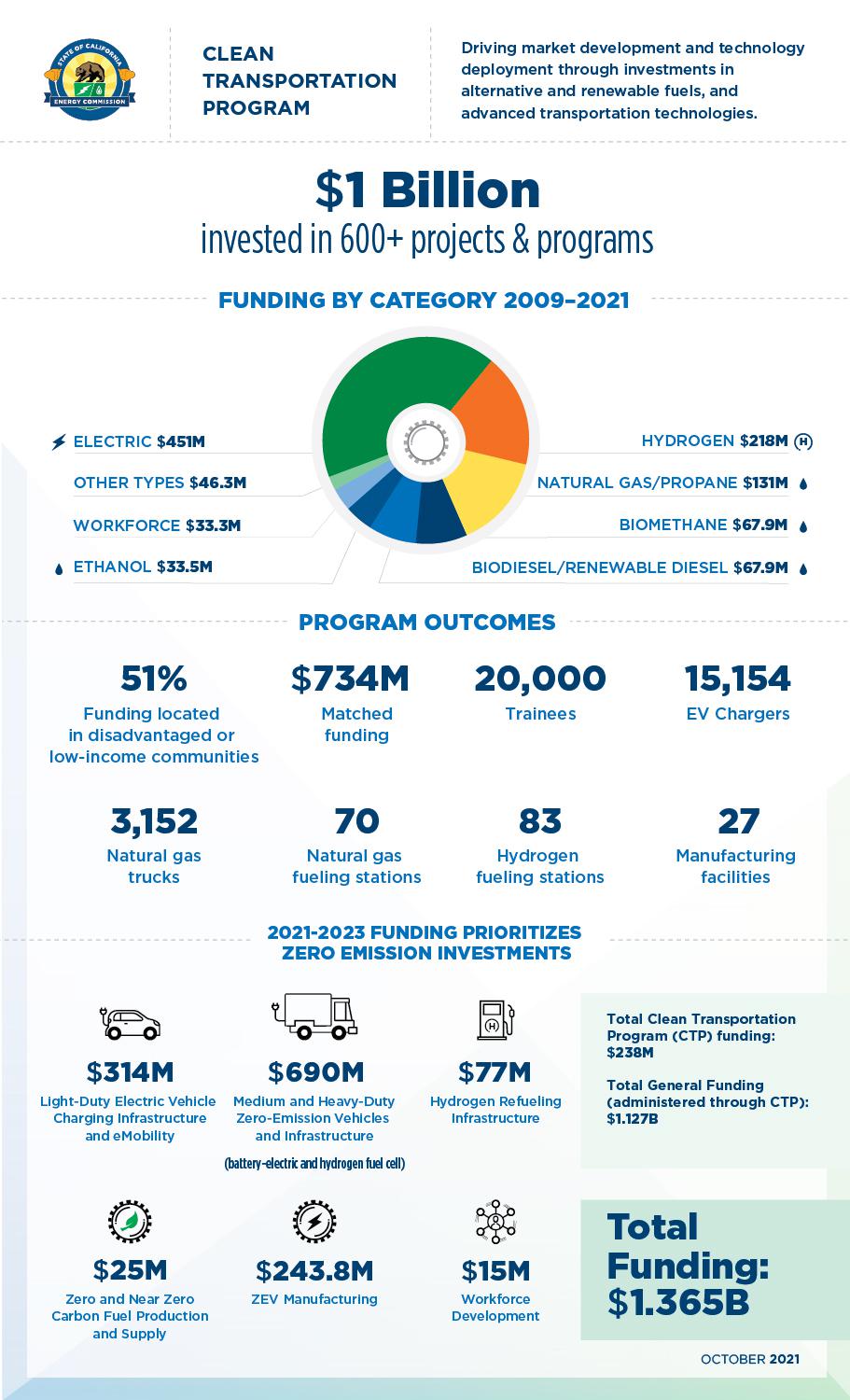For Immediate Release: November 15, 2021
Plan aims to close infrastructure gap and direct 50 percent of funds to priority communities.
SACRAMENTO – The California Energy Commission (CEC) today approved a three-year $1.4 billion plan to help California achieve its 2025 electric vehicle charging and hydrogen refueling goals. The plan closes the funding gap to speed up the state’s zero-emission vehicle (ZEV) infrastructure build-out in support of Governor Gavin Newsom’s executive order phasing out the sale of new gasoline-powered passenger vehicles by 2035.
The 2021–2023 Investment Plan Update plan increases the budget of the Clean Transportation Program by six times, including $1.1 billion from the 2021–2022 state budget in addition to the remaining $238 million in program funds.
“This plan charts the path for Governor Newsom’s historic budget investments in zero-emission transportation infrastructure and manufacturing,” said Lead Commissioner for Transportation Patty Monahan. “These dollars close the 2025 infrastructure funding gap so that access to charging and hydrogen fueling isn’t a barrier for those exploring cleaner transportation options including individuals, businesses and public agencies.”
The plan focuses on ZEV infrastructure build-out, with nearly 80 percent of available funding going to charging stations or hydrogen refueling. Investments are front-loaded, or allocated at the beginning of the process, to help ensure the public adoption of ZEVs is not stymied by lack of infrastructure.
The plan also prioritizes medium- and heavy-duty infrastructure, including funding for infrastructure for 1,000 zero-emission school buses, 1,000 zero-emission transit buses, and 1,150 zero-emission drayage trucks, which will reduce harmful air pollution in frontline communities. The plan also supports in-state ZEV manufacturing, workforce training and development, and near- and zero-emission fuel production.
The plan approved today includes:
- $314 million for light-duty electric vehicle charging infrastructure.
- $690 million for medium- and heavy-duty ZEV infrastructure (battery-electric and hydrogen).
- $77 million for hydrogen refueling infrastructure.
- $25 million for zero-and near-zero-carbon fuel production and supply.
- $244 million for ZEV manufacturing.
- $15 million for workforce training and development.
The funds will become available over the next two years and distributed to projects through a mix of competitive funding solicitations and direct funding agreements. The plan was guided by input from members of the Clean Transportation Program Advisory Committee, the Disadvantaged Communities Advisory Group, the state’s transportation and environmental agencies, and a broad range of stakeholders.
In response to engagement with these groups and others, the CEC remains committed to the goal of providing at least 50 percent of funds from this plan to projects that benefit priority populations, including low-income and disadvantaged communities.
Created by Assembly Bill 118 (Núñez, Chapter 750) in 2007 and reauthorized by Assembly Bill 8 (Perea, Chapter 401, Statutes of 2013), the Clean Transportation Program is one of the first transportation-focused funding efforts established to help advance the state’s climate change policies. Now in its 13th year, the program has provided more than $1 billion to projects across the state covering a broad spectrum of alternative fuels and technologies. Program funding is currently scheduled to sunset in January 2024.
On Friday November 19, the California Air Resources Board (CARB) will consider a complementary proposal for $1.5 billion in clean transportation incentives, including consumer vehicle rebates, and heavy-duty and off-road equipment investments.
Related Links
###
About the California Energy Commission
The California Energy Commission is leading the state to a 100 percent clean energy future. It has seven core responsibilities: developing renewable energy, transforming transportation, increasing energy efficiency, investing in energy innovation, advancing state energy policy, certifying thermal power plants, and preparing for energy emergencies.
Newsroom
Media Contact
Media and Public Communications Office
MediaOffice@energy.ca.gov
(916) 654-4989

